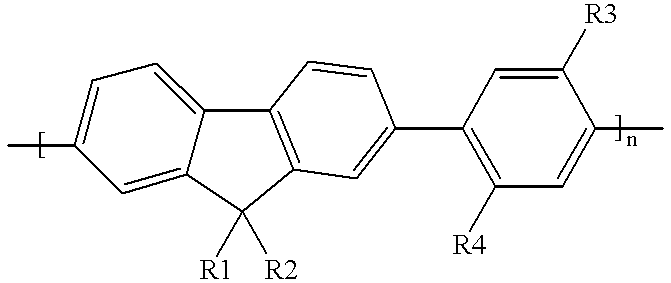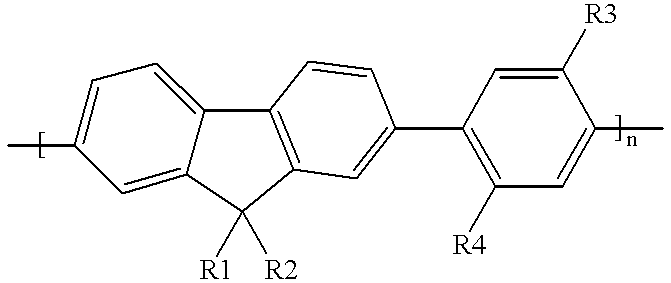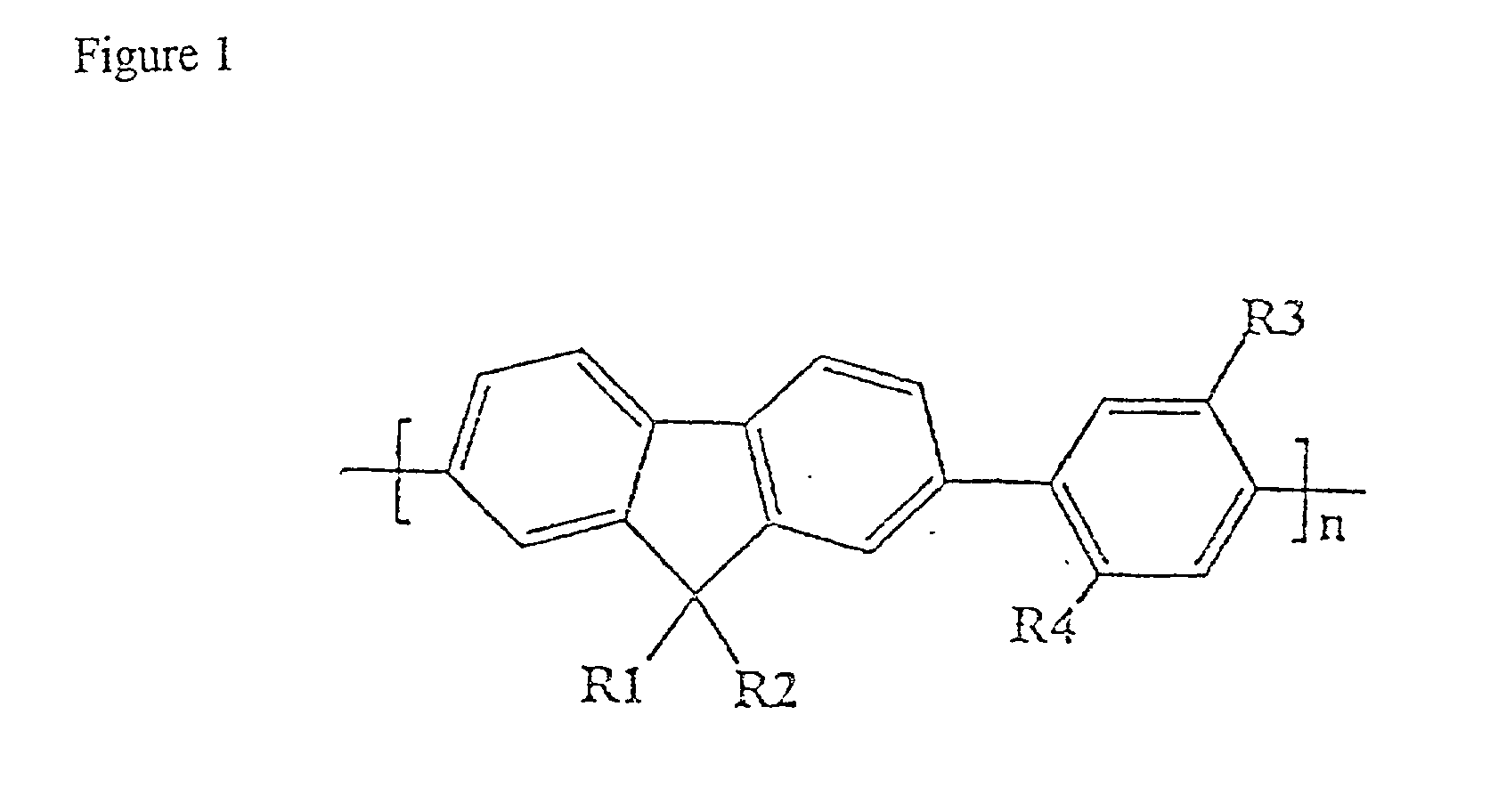Blue electroluminescent materials for polymer light-emitting diodes
a light-emitting diode and electroluminescent material technology, applied in the direction of discharge tube luminescnet screen, other domestic articles, natural mineral layered products, etc., can solve the problems of poor stability of polymers, limited application of polymer leds, and low molecular weight, and achieve the effect of almost none of the polymers that have demonstrated good el performan
- Summary
- Abstract
- Description
- Claims
- Application Information
AI Technical Summary
Problems solved by technology
Method used
Image
Examples
example 1
Synthesis of 2,7-Dibromo-9,9-dihexylfluorene from 2,7-Dibromofluorene
[0038] 9.72 g (0.03 mole) of 2,7-dibromofluorene, 27.2 g (0.165 mole) of n-hexyl bromide, 2.5 g (0.009 mole) of tetra-n-butylammonium chloride, and 60 ml of 50% NaOH aqeous solution were charged into a 250 ml round bottomed flask. The mixture was degassed by nitrogen flow at room temperature for 0.5 h, and then the mixture was vigorously stirred at 80.degree. C. under nitrogen for 12 h. The color of the reaction mixture changed from deep purple to orange and then finally to yellow. The reaction mixture was allowed to cool to room temperature. 100 ml of deinoized water was added and the mixture was extracted with ether. The combined ether solution was washed with water and brine and was dried over anhydrous MgSO.sub.4. The solvent was removed and the residue was recrystallized twice from ethanol to give 12.9 g of colorless crystal (87.5% yield). MS (EI, m / e): 492 / 100% (M.sup.+), 407 / 23.5%, 323 / 96.5%, 176 / 52.3%. .sup...
example 2
Synthesis of 2,7-Dibromo-9,9-Dioctylfluorene from Fluorene
[0039] To a solution of 25.0 g of fluorene in 200 ml of THF at -78.degree. C. was added dropwise 220 ml of 1.6 M butyllithium solution in hexane. The mixture was stirred at this temperature for 1 h and was then allowed to warm to 15.degree. C. The temperature was cooled down to -78.degree. C. again and 77.7 g of n-octyl bromide was added dropwise into the mixture. The solution was allowed to warm to room temperature and was stirred at room temperature for 12 h. The mixture was poured into water and was extracted with ether. The combined extracts were washed with water and brine and were dried over anhydrous magnesium sulphate. The solvent was removed by rotary evaporation. Distillation under reduced pressure gave 50 g of 9,9-dioctylfluorene as a pale yellow oil (212-214.degree. C. / 2 Toor) (yield 85.2%).
[0040] 50 g (0.128 mole) of the 9,9-dioctylfluorene was dissolved in 200 ml of chloroform and then 0.32 g of anhydrous ferric...
example 3
Synthesis of 9,9-Dihexylfluorene-2,7-Bis(Trimethylene Boronate)
[0041] 14.76 g (0.03 mole) of 2,7-dibromo-9,9-dihexylfluorene reacted with 1.58 g (0.066 mole) of magnesium turnings in 80 ml of dried THF (ignited by iodine) to generate the Grignard reagent. The Grignard reagent solution was added dropwise into a solution of 12.44 g (0.12 mole) of trimethyl borate in 200 ml of dried THF over a period of 2 h. The mixture was allowed to warm to room temperature and stirred for 36 h. The reaction mixture was poured into 1 Kg of crushed ice containing 30 ml of concentrated sulphate acid and the mixture was stirred at room temperature for 12 h. The aqueous solution was extracted repeatedly with ether (200 ml.times.4). The combined extracts were washed with water and brine. Most of the solvent was removed by rotary evaporation. Before the solid appeared, 50 ml of hexane was added to precipitate the solid. The solid was washed with hexane and was recrystallized from acetone to produce 9.5 g o...
PUM
| Property | Measurement | Unit |
|---|---|---|
| Wavelength | aaaaa | aaaaa |
| Wavelength | aaaaa | aaaaa |
| Wavelength | aaaaa | aaaaa |
Abstract
Description
Claims
Application Information
 Login to View More
Login to View More - R&D
- Intellectual Property
- Life Sciences
- Materials
- Tech Scout
- Unparalleled Data Quality
- Higher Quality Content
- 60% Fewer Hallucinations
Browse by: Latest US Patents, China's latest patents, Technical Efficacy Thesaurus, Application Domain, Technology Topic, Popular Technical Reports.
© 2025 PatSnap. All rights reserved.Legal|Privacy policy|Modern Slavery Act Transparency Statement|Sitemap|About US| Contact US: help@patsnap.com



